Cow Manure Predicted to Cause Most Sickness from Contaminated Wells in Kewaunee County
A study predicts the incidence of gastrointestinal illness in private drinking wells among residents of Kewaunee County, identifying manure as the main cause of contamination.
Wisconsin Watch
June 28, 2021 • Northeast Region
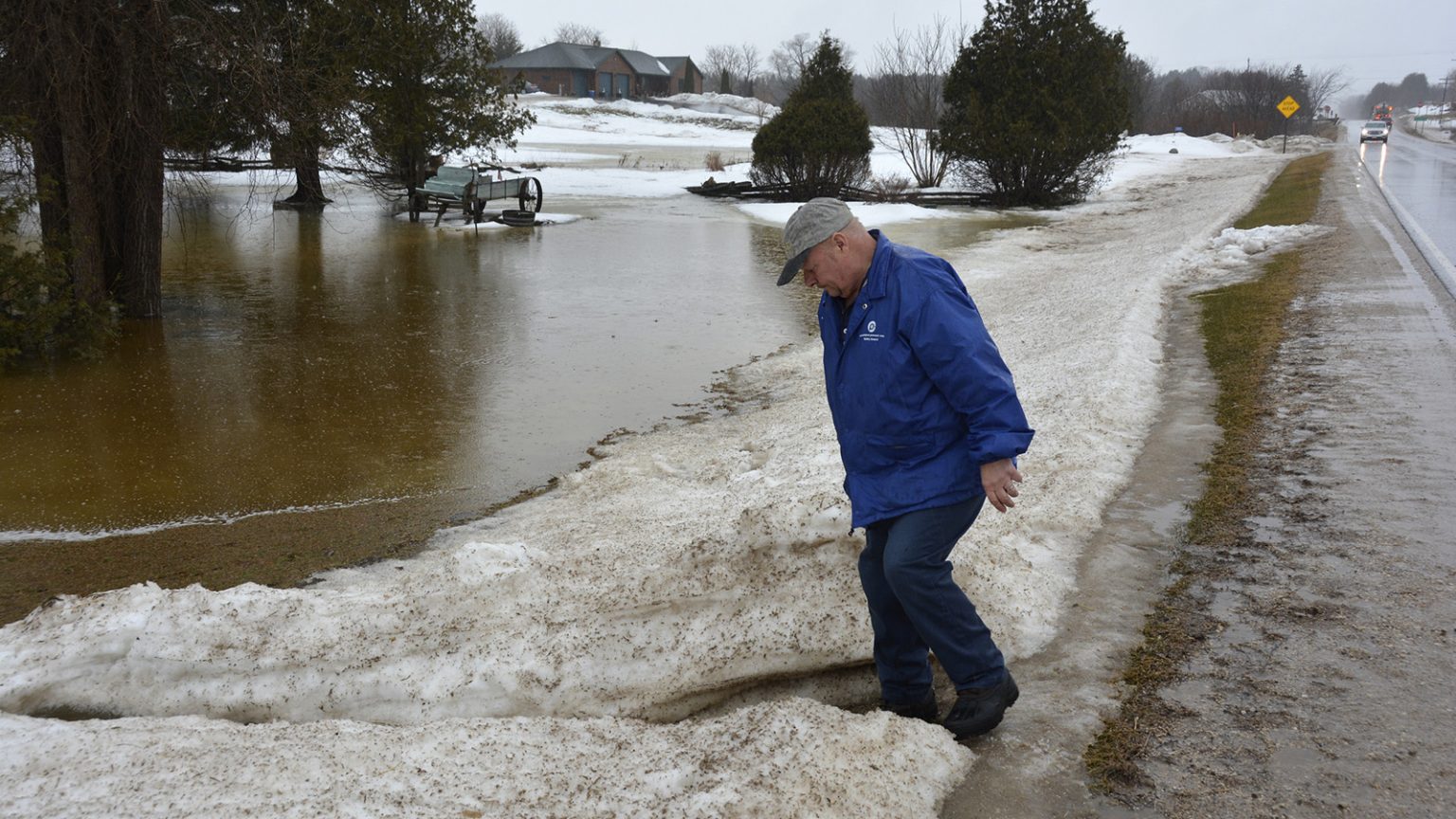
Arlin Karnopp takes water samples from his front yard during a rainstorm in the town of Montpelier, near Luxemburg. The water was found to contain manure, which had been spread on a neighboring field in the fall of 2018. The field where the spreading occurred backs up to his house. Photo taken March 14, 2019. (Credit: Tad Dukehart for Wisconsin Watch)

By Coburn Dukehart, Wisconsin Watch
The No. 1 factor for acute gastrointestinal illness in Kewaunee County’s private drinking water wells is cow manure, according to a federal study released in June 2021. The findings raise questions about the effectiveness of existing regulations aimed at protecting residents from tainted drinking water.
The study predicts that cow manure causes 230 cases of acute gastrointestinal illnesses in the county per year, out of 301 total cases of sickness — with an additional 12 cases caused by human waste from septic systems. The contaminant is unknown for the other instances, the authors wrote.
Symptoms of gastrointestinal illness can include nausea and vomiting, diarrhea and abdominal cramps, sometimes accompanied by fever. Children, the elderly and people with underlying health conditions can be more vulnerable to complications such as dehydration.
Kewaunee County, where cattle outnumber people nearly 5 to 1, has been at the forefront of discussions in Wisconsin over whether local, state and federal governments adequately protect private well water from contamination from dairy manure, especially in areas of fragile geology, including fractured bedrock, which is common in northeastern Wisconsin. The fractured Silurian bedrock allows for water to easily infiltrate to the subsurface, especially after rain or snowmelt.
The main source of illness in private wells was found to be the parasite Cryptosporidium, which was estimated to cause 250 cases of illness per year.
Additionally, the research reached a surprising finding: More than 80% of cases were predicted to come from wells located where the depth to bedrock is greater than 20 feet — where most people’s wells are located.
Fractured bedrock is the main geology in the county — characterized by porous rock with both horizontal and vertical fissures that allow contaminants in the soil to move quickly into the groundwater.
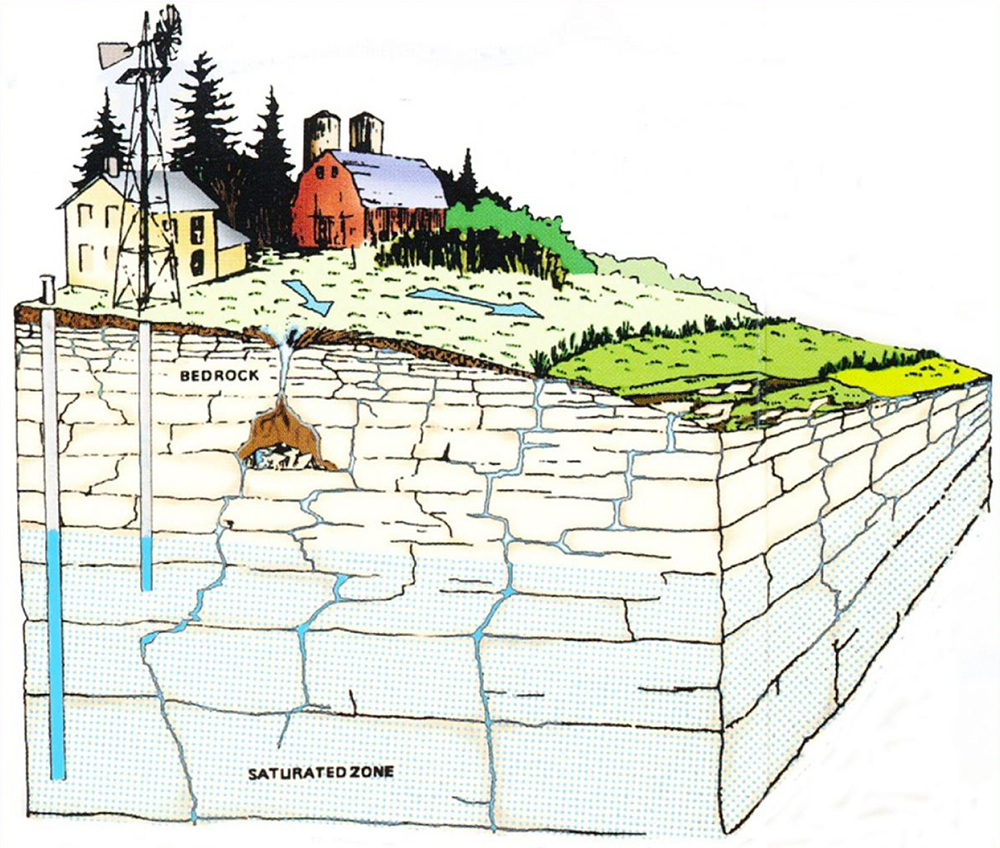
Fractured bedrock, also known as karst, is common in Kewaunee County. The vertical fractures can carry water and contaminants from the surface to the groundwater. At left are two wells drilled at varying depths into the aquifer. Research by U.S. Department of Agriculture scientist Mark Borchardt suggests that digging a deeper well does not protect it from contamination. (Credit: Courtesy of Door County Soil and Water)
The study, by lead author Tucker Burch, a U.S. Department of Agriculture research agricultural engineer, was published today in the journal Environmental Health Perspectives. Also published was a companion study by USDA microbiologist Mark Borchardt, which found nitrate and coliform in Kewaunee’s drinking wells mostly comes from agriculture — not human waste from septic systems.
Borchardt’s study examined the sources of well water contamination and which factors can reduce or increase the risk of tainted drinking water. His team used models to predict how those factors — like the distance of a well from a manure lagoon or agricultural field, number of septic systems, weather and the quality of well construction — can impact the levels of contamination. He presented initial findings at the Midwest Manure Summit in Green Bay in 2019.
That study found that the main risk factor for well contamination by coliform bacteria was its proximity to a manure storage pit, a common method used by large farms to store and later dispose of manure. Additionally, it found that digging a deeper well did not protect that well from getting contaminated, meaning that even if a homeowner gets a new well drilled, that may not protect the household from contamination.
Burch’s study was based on a year-long, countywide pathogen occurrence study conducted from April 2016 to March 2017 that examined 138 private well samples. Borchardt’s study was based on those samples, as well as hundreds of others tested for coliform and nitrate analysis. According to Borchardt, the two papers represent the most comprehensive, site-specific private well study conducted to date in the U.S.
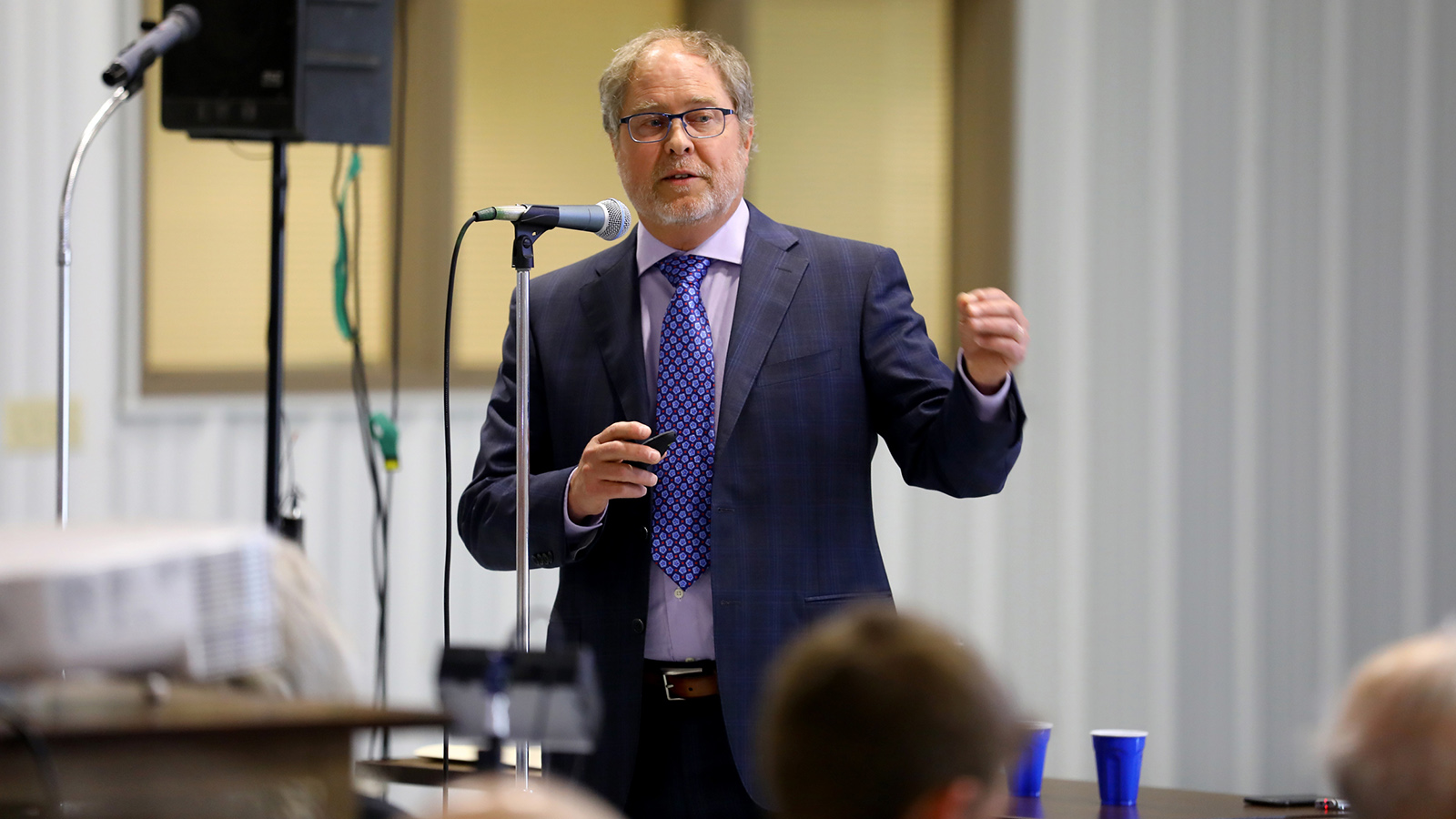
Mark Borchardt, a microbiologist with the U.S. Department of Agriculture, presents data on water contamination in Kewaunee County, during a meeting at the Expo Hall at the Kewaunee County Fairgrounds on June 7, 2017. His research found the risk of contamination from nitrate and coliform is more closely tied to animal manure than human waste. (Credit: Coburn Dukehart / Wisconsin Watch)
A leading farmer in the area questioned the value of the findings of Burch’s study, saying manure practices have improved significantly since those water samples were taken.
Don Niles, a Kewaunee County dairy farmer and president of the nonprofit Peninsula Pride Farms says farmers in Door and Kewaunee counties are now using improved techniques to manage manure, including planting more cover crops to improve soil health. And, he says about half of all manure spread on shallow soils in Kewaunee County now goes through a digester first.
“That’s been a major push up here because we wanted that pathogen reduction,” he said.
“We have to demonstrate that we’ve destroyed 999 organisms out of 1,000 (before landspreading the manure). So a 3,000-cow dairy that digests manure now is spreading the same amount of coliforms as a three-cow dairy with no digester. So that’s substantial. That’s not just taking a little off the edge.”
Regulations fall short?
Burch’s report could have important implications for land use and water resource management in Kewaunee County — and elsewhere across the state with a fractured bedrock geography — as it predicts for the first time the number of acute gastrointestinal illnesses and the specific fecal source.
Burch’s research team is conducting a similar study in the southwestern Wisconsin counties of Iowa, Grant and Lafayette, and hope to present findings in the fall. A study of groundwater conducted in 2018 in those counties found that 34% of 301 sampled wells tested positive for coliform, 16% for nitrate, and 4% for E. Coli.
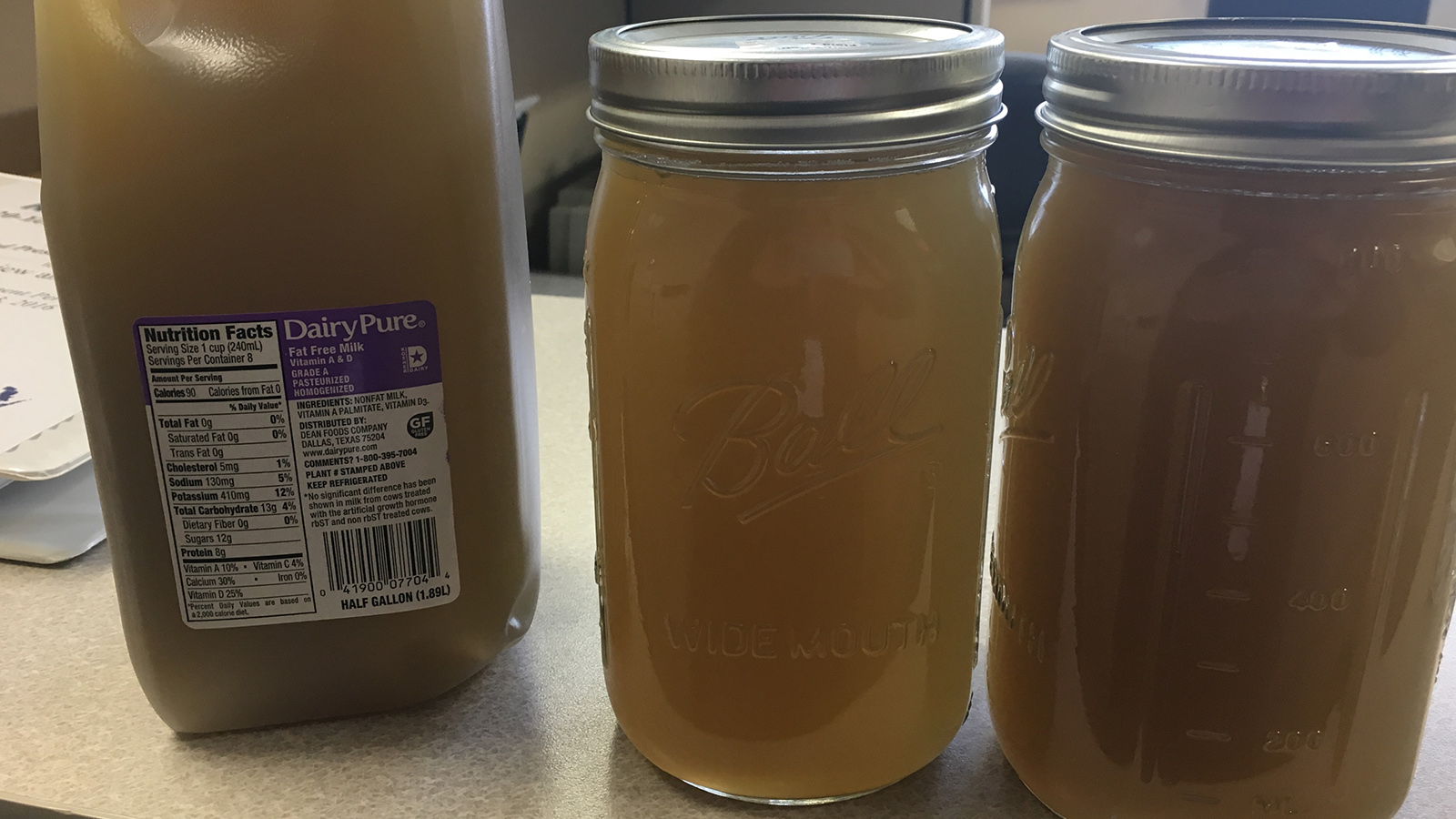
These jars contain brown water taken from a tap in Kewaunee County that researchers tied to spreading of manure on a nearby field in 2016. The soil from the field and water from the home shared the same signatures for fecal contaminants. (Credit: Courtesy of Kewaunee County Land and Water Conservation Department)
According to Burch’s report, private wells are the primary source of drinking water for about 12,000 Kewaunee County residents. Private wells in Wisconsin are not monitored by government agencies, and the maintenance and testing of well water is in the hands of the well owner. When a well or land becomes tainted with runoff from a neighboring farm, homeowners often don’t have recourse, unless they can prove it was contaminated by livestock waste.
Private homeowners in that situation may be eligible for a well compensation program that provides money for filling and sealing old wells, drilling and constructing a new well or installing a treatment system. If they have E. coli in their well, Peninsula Pride Farms’ “Water Well” program also offers help.
But Borchardt’s research shows that a new or deeper well does not necessarily provide protection.
New manure rules for northeastern Wisconsin
Recent changes to the state’s manure management rules prohibit all dairy farms in areas of the state with Silurian bedrock from mechanically applying manure on fields with less than 2 feet of soil over bedrock or groundwater. Also prohibited are mechanical applications of manure when an inch or more of rain has fallen in the previous 24 hours and on frozen or snow-covered ground with less than 5 feet of soil over bedrock. And manure applications must be 250 feet away from drinking water wells.
These standards are part of a set of rules known as NR 151, which ban fecal contamination of drinking water by mechanical manure application.
Joe Baeten, the northeast watershed management regional supervisor for the state Department of Natural Resources, says the updated rules, passed in 2018, will be slowly implemented over the next 10 years as large farms known as concentrated animal feeding operations, or CAFOs, get new or reissued permits. Smaller farms that land spread manure are also required to follow the rules.
The rules apply to some areas in Brown, Calumet, Dodge, Door, Fond du Lac, Kenosha, Kewaunee, Manitowoc, Milwaukee, Outagamie, Ozaukee, Sheboygan, Racine, Walworth, Washington and Waukesha counties.
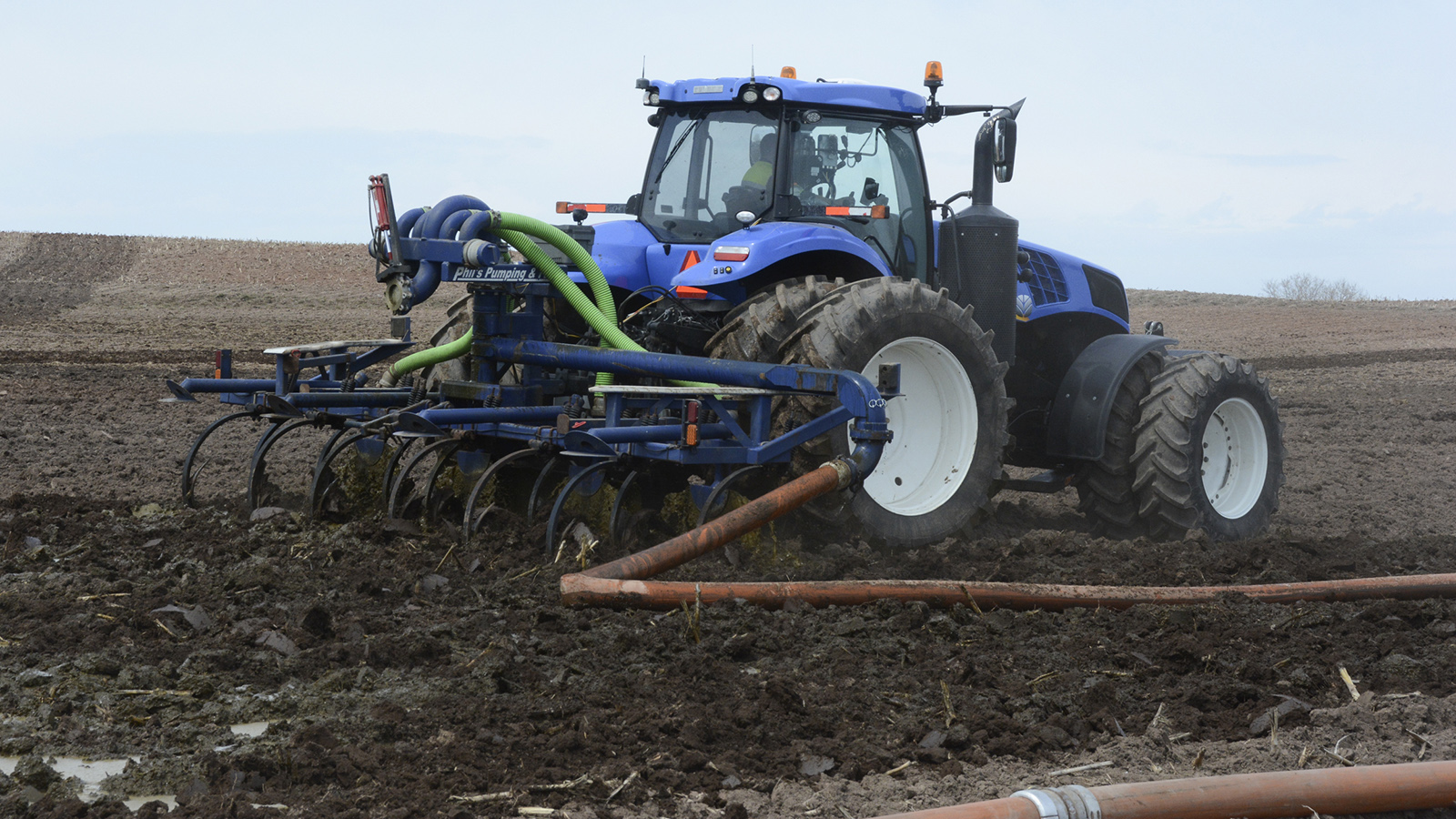
Manure is spread on a farm field during the Door-Kewaunee Watershed Demonstration Farms Networks Spring Field Day at Heims Hillcrest Dairy, in Casco on May 1, 2018. A study predicts that cow manure causes 230 cases of acute gastrointestinal illnesses in Kewaunee County per year. (Credit: Tad Dukehart for Wisconsin Watch)
The regulations place the most restrictions on solid and liquid manure spreading in areas between 2 and 5 feet to the bedrock. There are fewer restrictions on areas with soil depth between 5 and 20 feet. But, Burch noted that shallow wells are uncommon in the county and, “Most people in the county have wells in the greater than 20 foot depth-to-bedrock category.”
To monitor the impact of the updated rules, Baeten says the DNR, in partnership with the Wisconsin Geologic and Natural History Survey, is designing a new project that will put groundwater monitoring wells around the northeastern part of the state. At least one site will be located in the Kewaunee/Door County area and will consist of 12 monitoring wells with controlled variables such as manure application rates and field conditions.
The DNR was a funder of Borchardt’s original research, and Baeten says the findings helped inform the rulemaking process. “Now that the rules are in place, we want to know, will the rules work?” Baeten said. “Down the road there might be another phase where we ask, ‘Did the rules work after we got past 10 years of implementation? Have we seen results?’ It’s a long phased process.”
Lagoons, landspreading eyed as sources
Scientists who testified in Stevens Point before the Assembly’s Water Quality Task Force in 2019 told lawmakers that for rural residents to have clean drinking water, farmers must change how they manage fertilizers, including manure.
Borchardt’s and Burch’s research also suggests that current farming practices are contributing to well contamination and illness, because of the way manure leaks from storage lagoons and manure spread on land seeps through the bedrock into the aquifer and private wells.
Niles, however, challenged the design of Burch’s new study, saying it overstates the level of disease in the area. He noted that the study is predictive, not epidemiological, and does not reflect the number of cases reported to local health officials.
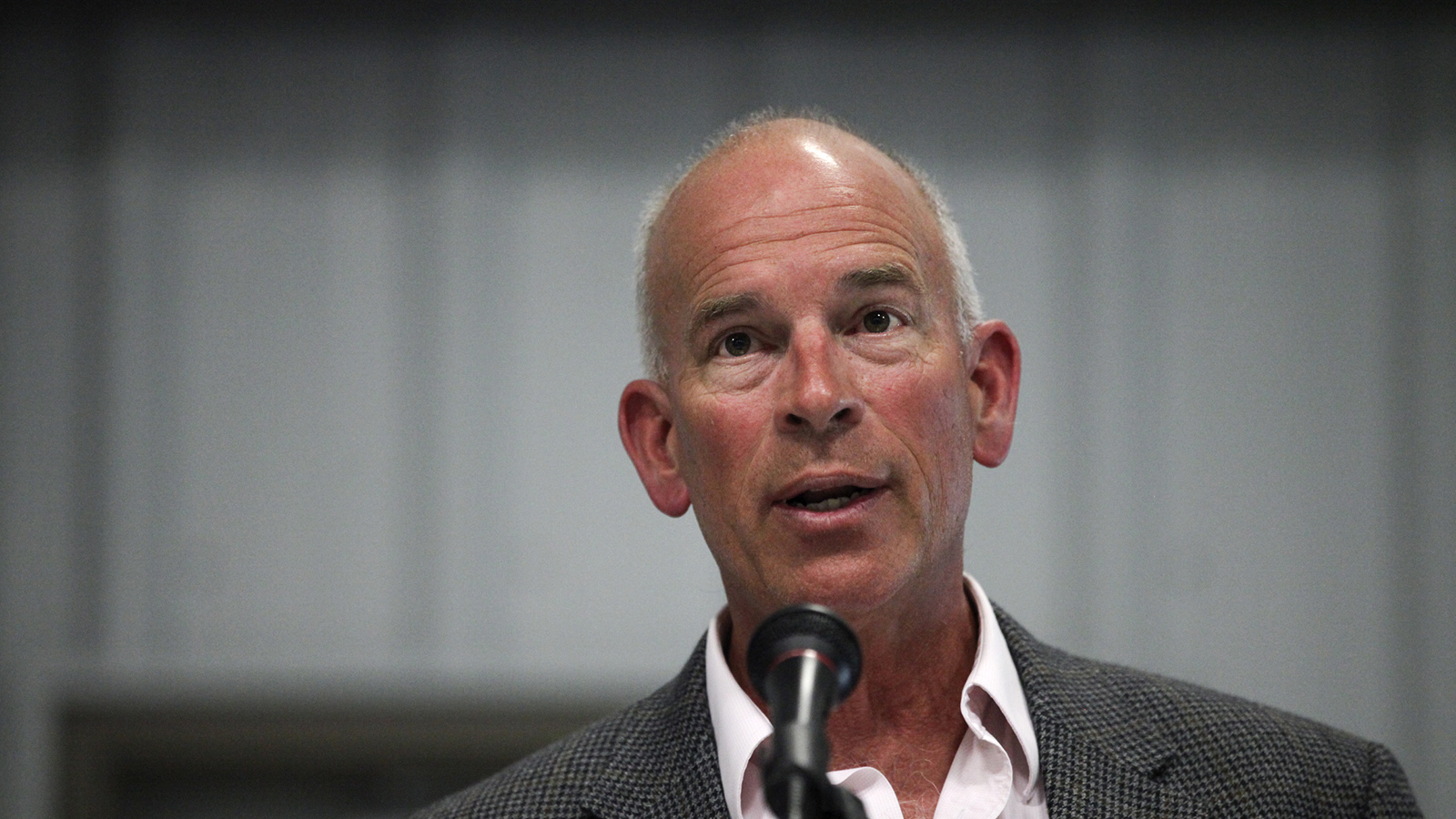
Don Niles, a Kewaunee County dairy farmer and president of the nonprofit Peninsula Pride Farms says farmers are trying to reduce the chance for water contamination through improved manure handling practices. He is seen at a meeting at the Kewaunee County Fairgrounds in Luxemburg, Wis., June 23, 2016. (Credit: Coburn Dukehart / Wisconsin Watch)
But the researchers note that their findings are consistent with actual cases reported to the Kewaunee County Public Health Department.
That department reports an average of 4.5 cryptosporidiosis cases per year between 2015 and 2020, and 4.2 cases of salmonellosis. But Burch says those numbers are artificially low, as such ailments tend to be underdiagnosed and underreported. He says scientific literature suggests that for every one case of cryptosporidiosis reported, there are 100 more that go unreported. For salmonellosis, the comparison is 1 to 30.
Said Burch: “The reason for this is that not everyone who gets one of these diseases goes to see a doctor, not everyone that sees a doctor gets tested, the tests involved don’t always work perfectly, and the test results don’t always get reported to public health agencies.”
Current rules do not protect drinking water
All of the 17 CAFOs in Kewaunee County have nutrient management plans (NMPs) designed to regulate when, where and how much manure can be spread on agricultural fields. These plans are recommended by the Department of Agricultural, Trade and Consumer Protection (DATCP) to meet crop nutrient needs while also reducing the potential for manure and other nutrients to run off into ground and surface waters. Farms including CAFOs, those enrolled in the Farmland Preservation Program and those that accept state subsidies are required to have such a plan. For the rest of Wisconsin’s farms, the plans are voluntary.
According to DATCP, in 2020 about 36% of Wisconsin’s croplands have such a plan, and about 70% of farms are in compliance with the terms. But the conservation group Wisconsin’s Green Fire published a 2019 report on nitrates in drinking water citing estimates as low as 15% compliance. Additionally, the advocacy group, which is made up of Wisconsin experts in natural resource management, environmental law and scientific research, proposed offering farmers incentives to embrace the plans. They also argued for strengthening the existing standards to make sure that groundwater is protected. “In high-risk areas (including, but not limited to, areas of shallow or sandy soil, or areas with porous bedrock), compliance with existing nutrient management guidelines is by itself insufficient to protect water quality,” the report said.
Other experts agree, saying these plans are primarily designed to benefit crops, not drinking water.

The house owned by Arlin and Mary Lou Karnopp near Luxemburg backs up to farm fields where manure is spread on the land. The Karnopps’ well has tested positive for nitrates and coliform over the years, and they no longer drink or cook with the water. Research by U.S. Department of Agriculture scientist Mark Borchardt found that high nitrate contamination is linked to the presence of agricultural fields and manure lagoons. Photo taken March 29, 2019. (Credit: Coburn Dukehart / Wisconsin Watch)
James Matson, retired DATCP chief legal counsel, wrote the 2017 report, “Food, Land and Water — Can Wisconsin Find Its Way?,” with contributions from Ed Odgers, retired chief agricultural engineer for DATCP. The report said the amount of manure grows every year as milk production rises — and many areas of the state can’t handle the increased volume.
According to the report, Wisconsin cows produce roughly 64 billion pounds of manure, a combination of feces and urine — about 7% more than in the previous decade.
In a 2018 interview, Odgers said that a nutrient management plan “is a very generalized standard, it is not a standard that is designed to ensure environmental protection.”
“That’s in part why a lot of the farms, for example in Kewaunee County, are meeting current standards, but those standards … are not adequate, in my personal opinion, to meet the very vulnerable site conditions that we have there.”
In fact, Borchardt says that the more fields with nutrient management plans surrounding a well, the greater the chance is that the well will be contaminated with high nitrate. “This suggests nutrient management plans in Kewaunee County are not mitigating nitrate contamination of groundwater,” he said.
Tainted well, yard full of manure
One family who has experienced the effects of high nitrates and bacteria in their well water is Arlin and Mary Lou Karnopp near Luxemburg, Wisconsin — about 20 miles east of Green Bay in Kewaunee County. Their household was part of the original well water study conducted by Borchardt and Maureen Muldoon, a geology professor from the University of Wisconsin-Oshkosh. Their well was sampled multiple times, with one test showing elevated levels of coliform bacteria, another showing elevated levels of nitrate-nitrogen. In 2016, the Karnopps stopped drinking or cooking with their well water although they do use it to shower.

Arlin and Mary Lou Karnopp live near Luxemburg, on property once owned by Arlin’s great-grandfather. Their house backs up to a field managed by Rolling Hills Dairy farm, where manure is spread. The Karnopps’ well has tested positive for nitrates and coliform over the years, and they no longer drink the water. They are afraid to let their grandchildren play in their yard due to fears over contaminated soil. Photo taken March 29, 2019. (Credit: Coburn Dukehart / Wisconsin Watch)
The Karnopp family has suffered many health problems over the years. Their son-in-law who lives in nearby Casco, Wisconsin had stage 3 colon cancer, which can be caused by high nitrates in water. Their grandson was born without a hip. Mary Lou has suffered multiple bladder infections tied to E. coli, and in 2020, she had a stroke. The Karnopps can’t prove the health issues are due to tainted water, but say they continue to wonder whether that was the cause.
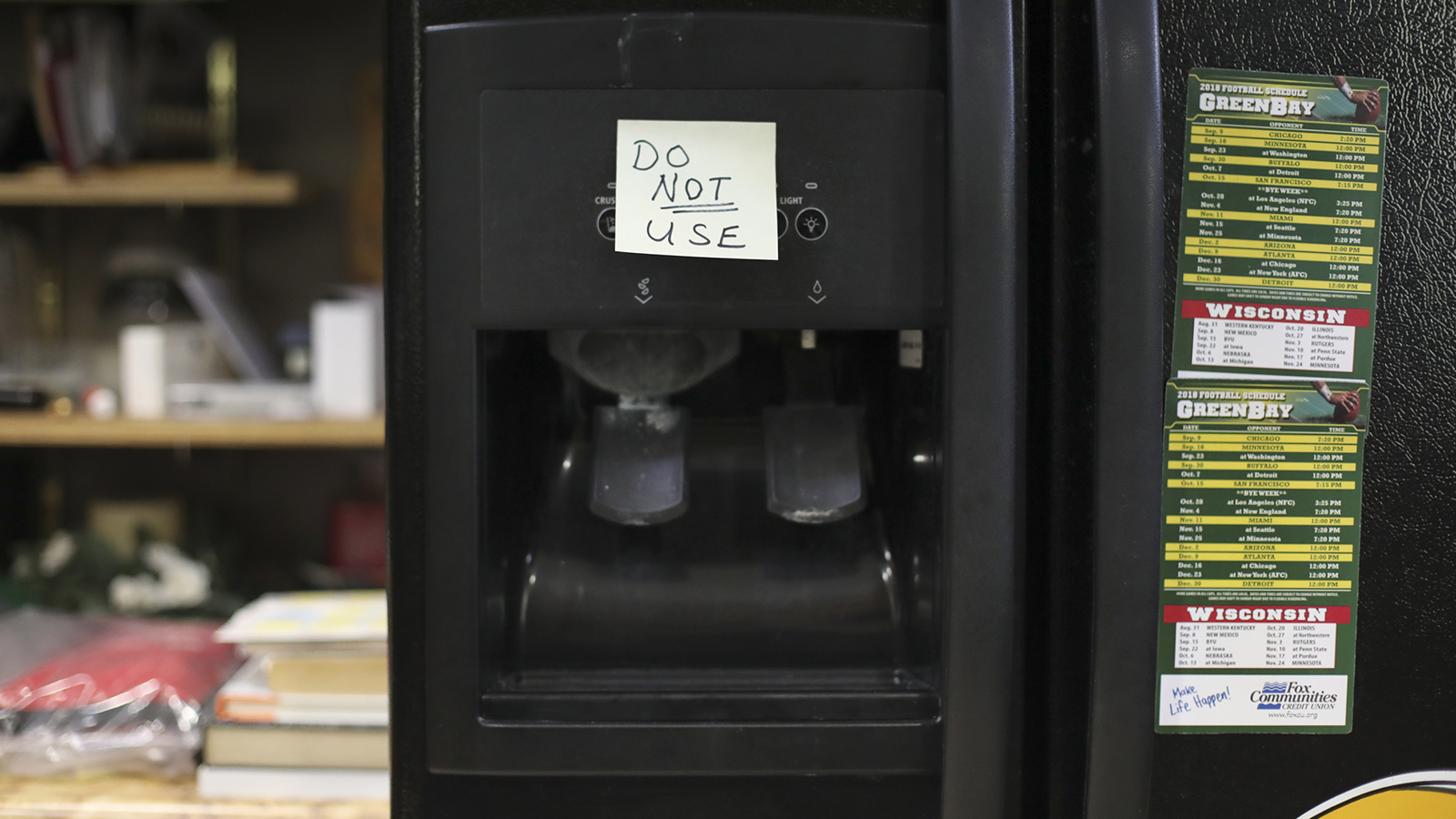
The Karnopps of rural Luxemburg warn visitors not to drink the water from taps in their home. Photo taken March 29, 2019. (Credit: Coburn Dukehart / Wisconsin Watch)
In addition to a contaminated well, the Karnopps suffered an additional manure-related catastrophe in February 2019 when frozen manure spread on a neighbor’s property thawed in a rainstorm, flowed downhill and flooded their yard with liquid manure. When the weather got colder, it froze into place. And then it melted, leaving a pool of manure-contaminated water 50 feet around and several inches deep.
Karnopp took water samples, which showed results that were “indicative of manure,” according to James Iverson from the private lab Analytichem. The DNR took samples which tested positive for E. coli.
Various representatives from the county and state inspected their property. The state DNR notified Halls Calf Ranch, which spread the manure on the property, that it was violating its state wastewater permit, and the farm was ordered to have “no further unauthorized discharges to waters of the state as a result of manure runoff.”
To date, the Karnopps have received no compensation for the mishap from the government or the neighboring CAFO where the manure was spread — which has already been cited for multiple other violations.
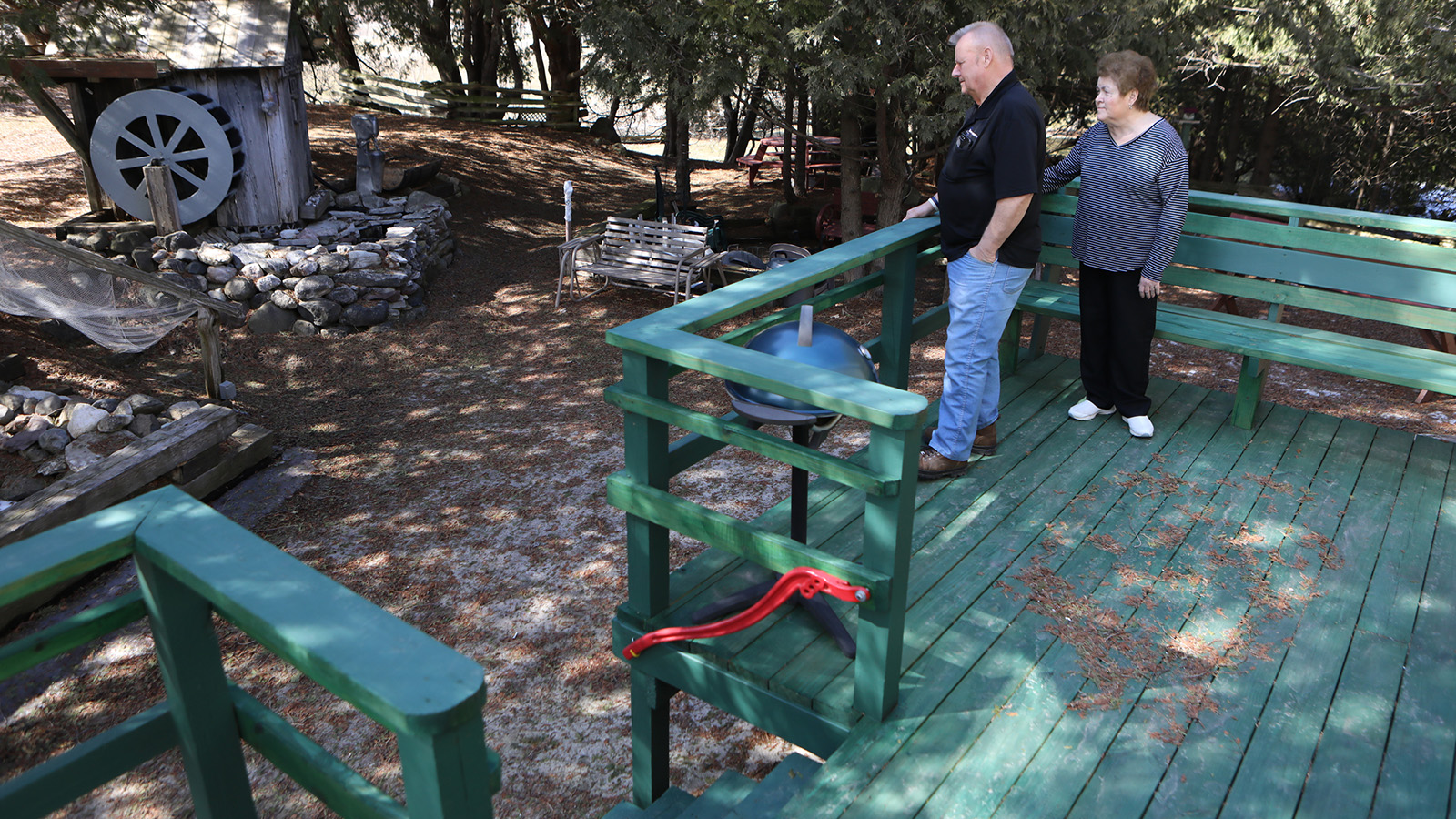
Arlin and Mary Lou Karnopp look over their backyard near Luxemburg. The couple’s well has tested positive for nitrates and coliform over the years, and they no longer drink or cook with the water. Photo taken March 29, 2019. (Credit: Coburn Dukehart / Wisconsin Watch)
The Karnopps are weighing whether to dig a new well — or even sell the home built on land once owned by Arlin’s great-grandfather. ”The value of my home is gone. That’s the worst part, if we want to sell, we have a contaminated well. Being our age, if we want to sell we aren’t going to get anything for it,” he said.
And he remains skeptical the family will have a positive resolution. In a recent email, he wrote, “We might as well talk to a brick outhouse.”
This piece was produced for the NEW News Lab, a local news collaboration in Northeast Wisconsin. The nonprofit Wisconsin Watch collaborates with WPR, Wisconsin PBS, other news media and the University of Wisconsin-Madison School of Journalism and Mass Communication. All works created, published, posted or disseminated by Wisconsin Watch do not necessarily reflect the views or opinions of UW-Madison or any of its affiliates.
 Passport
Passport







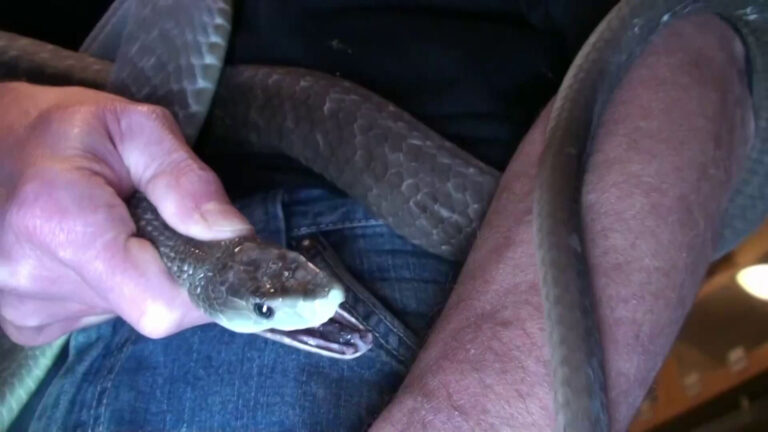



Follow Us